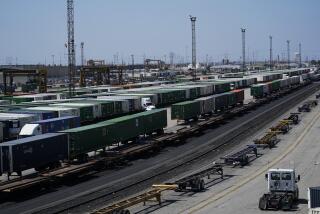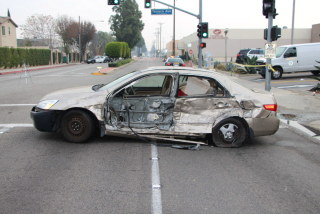Railroad Admits 2 Errors in Derailment
- Share via
Southern Pacific Transportation Co. officials, quoting results of a preliminary investigation, Monday blamed company workers for failing to properly couple 14 freight cars that rolled from a City of Industry switching yard and smashed into three locomotives stopped eight miles away in Pico Rivera.
Southern Pacific spokesman Andy Anderson said a switch in the City of Industry yard was “mistakenly” left open, allowing the string of freight cars to wander onto a Union Pacific line and into the path of the locomotives.
“There was an error in coupling and they got loose,” Anderson said of the freight cars, nine of which derailed in the collision. “The second mistake was that the switch on the Union Pacific line was opened.”
Anderson declined to say what, if any, penalties would be imposed on the workers, pending further investigation.
Meanwhile, investigators from the state Public Utilities Commission, the National Transportation Safety Board and the Federal Railroad Administration continued their probes of the Sunday morning crash that sent the nine cars hurtling into the back yards of at least seven Pico Rivera homes.
No damage estimate has been made. Anderson said the company’s liability would be determined by the amount of damages.
“I would guess we are talking about a couple hundred thousand dollars, mostly in railroad equipment,” he said.
There were no injuries in the 9:44 a.m. collision, which rattled several blocks near Whittier and Paramount boulevards. None of the cars were carrying volatile or hazardous materials. One freight car landed only inches from a kitchen where a woman was feeding her 3-month-old son. Another car, which was parked on an adjacent track, was knocked into a garage.
A preliminary investigation by the Federal Railroad Administration appeared to concur with Anderson’s explanation of the accident.
“The cars probably broke free after they were improperly connected to a locomotive in the Industry train yard,” said administration spokesman Steve Borows. “They rolled onto the Union Pacific line and that is what caused the mishap.”
Borows said that “if our investigation shows it was human error, the railroad can be cited for violating safety regulations and a monetary fine can be imposed.”
“If they find it was human error that borders on gross negligence or that it was a mishap based on gross misconduct, the fine can be substantial,” he said.
Separately, Union Pacific officials praised “quick, smart thinking” on the part of dispatchers 1,100 miles away in Omaha, Neb., and their four-man locomotive crew in Pico Rivera, who, with minutes to spare, frantically searched for the safest place to park their 400-ton engines and absorb the impact.
“They were trying to avoid adjoining buildings, bridges and highways--and they only had 10 minutes to do it,” said Union Pacific spokesman John Bromley, commenting on the time between detection of the runaway cars and impact.
“They shaved it really thin,” Bromley said. After the crew stopped the locomotives and set the brakes, “the men started running. They managed to run 100 yards when the runaways hit their train.”
Minutes earlier, Union Pacific officials at the railroad’s new $48-million electronic dispatch center had scotched a plan to switch the runaway cars onto a track that would have sent them careening across an Amtrak line at 60 miles an hour.
“We were very concerned about possibly hitting an Amtrak train,” Bromley said. “So, we elected to take the hit ourselves.”
Anderson said that although Southern Pacific plans to install a special switching mechanism in the City of Industry yard that will automatically derail loose cars before they can roll onto a mainline, there is little the railroad can do to prepare for collisions involving runaway cars.
“They are a pretty rare occurence,” Anderson said. “We just have to police what our people do in the yards.”
Bromley agreed, saying, “We don’t have a chance to practice this sort of scenario very often.”
“It is like an airline pilot--you work for 20 years in boredom and eight seconds of sheer terror and hope that when that time comes everybody does the right thing,” he said. “In this case, it looks like everybody did.”
Meanwhile, railroad accidents are increasing across the state, according to federal statistics. In 1988, there were 109 train accidents, compared to 151 in 1989.
The surge in railroad accidents last year, which included the derailment of a runaway Southern Pacific freight train in west San Bernardino that resulted in four deaths, prompted the PUC to hire four additional safety inspectors to enforce state and federal railroad regulations.
Union Pacific’s railroad line through Pico Rivera was expected to be cleaned up and reopened late Monday afternoon.
“My kids are pretty upset, every time they hear a train rumble by they are going to be afraid,” said Theresa Marquez, 35, whose garage was heavily damaged by a freight car. “It’s going to be like having an earthquake every time a train goes by.”
More to Read
Sign up for Essential California
The most important California stories and recommendations in your inbox every morning.
You may occasionally receive promotional content from the Los Angeles Times.











